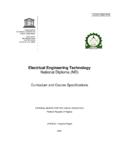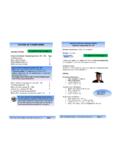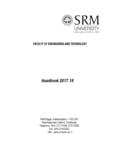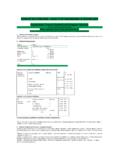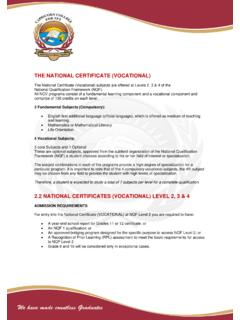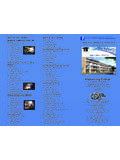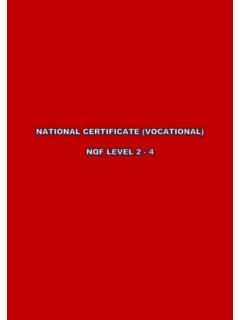Transcription of 4th Edition - WHO
1 INational Medical Equipment Policy Fourth Edition , 2009 The Republic of UgandaMi n i s t r y of He a l tHna t i o n a l Me d i c a l eq u i pM e n t po l i c y4th Edition 2009iiNational Medical Equipment Policy Fourth Edition , 2009 Ministry of HealthNational Medical Equipment Policy, 4th edition , 2009 Kampala UgandaCompiled and Produced by: The national Advisory Committee on Medical EquipmentMinistry of Health, KampalaTechnical Editing, Typesetting and Printing by:Logik Media, Box 22271 Kampala UgandaMarch 2009iiiNational Medical Equipment Policy Fourth Edition , 2009 TablE of ConTEnTsAcronyms ..ivForeword ..viChapter 1: IntroductIon ..1 Chapter 2: SItuAtIon AnAlySIS .. Policy Implementation and Management .. national Advisory committee on Medical Equipment (nAcME).
2 Health Infrastructure division (HId) .. national referral Hospitals .. regional referral Hospitals .. district Health Services ..7 Chapter 3: PolIcy contEXt ..8 Chapter 4: PolIcy oBJEctIVE .. General objective .. Specific Objectives ..11 Chapter 5: GuIdInG PrIncIPlES .. Acquisition .. regulation, operation and Quality .. Maintenance .. Monitoring and Evaluation .. disposal of Medical Waste ..27annEx 1: list of ParticipantsMedical Equipment Stakeholders conference ..29annEx 2: list of nAcME Members ..34ivNational Medical Equipment Policy Fourth Edition , 2009aCRonYMsBP Blood PressureBRSB asic Radiological systemCEConformite EuropeenneCRSC omputed Radiological SystemCTComputer Tomography ScannerCWSC entral WorkshopDDHSD istrict Directorate of Health ServicesDIND eutche Industrie NormECGE lectrocardiogramEEGE lectroencephalographyENTEar, Nose.
3 ThroatESR Erythrocyte Sedimentation RateGHGeneral HospitalGoUGovernment of UgandaHCIIH ealth Centre Level 2 HCIIIH ealth Centre Level 3 HCIVH ealth Centre Level 4 HCTH eamatocritHIDH ealth Infrastructure DivisionHMISH ealth Management Information SystemHSDH ealth Sub DistrictICUI ntensive Care UnitIECI nternational Electro CommissionISOI nternational Standards OrganizationIUDI nsertion and DrainageJICAJ apan International Cooperation AgencyLCDL iquid Crystal DisplayMCHM aternal Child HealthMOHM inistry of HealthMRIM agnetic Resonance Imaging SystemNACMEN ational Advisory Committee on Medical EquipmentNDAN ational Drugs AuthorityNRHN ational Referral HospitalvNational Medical Equipment Policy Fourth Edition , 2009 NRMHN ational Referral Mental HospitalOPDOut Patient DepartmentPCBP olychlorinated BiphenylPCR SystemPolymerase Chain Reaction Test SystemPET SystemPositron Emission Tomography and Related Equipment SystemPHCP rimary Health CarePPDAP ublic Procurement and Disposal AuthorityRRHR egional Referral HospitalSPECTS ingle Photon Emission Computed Tomography and Related SystemUNBSU ganda national Bureau of StandardsUPSU ninterrupted Power SupplyVDRLV enereal Disease Research Laboratory (Syphilis Test)WHOW orld Health OrganizationviNational Medical Equipment Policy Fourth Edition , 2009foREWoRD In 1989, the then Hon.
4 Minister of Health appointed a national Advisory committee on Medical Equipment (nAcME) to prepare a policy to guide the sector on acquisition and management of medical equipment. The committee produced the first national Medical Equipment Policy in 1991 which assisted both government and non government agencies to rationalize procurement and management of medical the years, the medical equipment policy and guidelines have been reviewed to update equipment specifications so as to conform to new technological advancements and medical techniques. the second and third editions of the Medical Equipment Policy and Guidelines came out in 2000 and 2003 fourth Edition has been structured to provide guidance on:Medical equipment management cycle. Standard list of equipment for each healthcare level Detailed technical specifications for recommended medical equipment the guidelines and lists of essential equipment for each healthcare level are a result of extensive discussions and consultations with a number of stakeholders.
5 Equipping of health facilities in uganda should therefore be carried out based on the principles set out in this policy to ensure rationalized and coordinated equipping of health facilities. It is my pleasure to write this foreword to the fourth Edition of Medical Equipment Policy and Guidelines, 2009 and to thank the chairman, Members of the national Advisory committee on Medical Equipment and all those who participated in one way or the other in its preparation. Dr sam ZarambaDIRECToR GEnERal of HEalTH sERVICEs1 national Medical Equipment Policy Fourth Edition , 2009 CHaPTER InTRoDUCTIon Medical equipment represents a substantial asset in the health care delivery system and needs to be managed efficiently. Moreover, the way in which it is purchased, managed and used can influence the quality of health care delivered to patients.
6 Medical equipment can pose a risk to patients and staff, particularly if used daily, periodic and corrective maintenance of medical equipment is key to achieving safe and cost-effective management of medical equipment. Adequate operation and daily maintenance budgets should be allocated to Health Facilities. In order to guide investments, sufficient advisory and supervisory capacity needs to be developed by HId and in all the health facilities operated by PnFPs. operation and maintenance capacity development should be systematically in line with the increasing demand. It is difficult for low income countries to procure cost-effective equipment for their health care sectors. the challenge therefore is for the country to incorporate the experiences gained over the years into this Medical Equipment Policy.
7 This is the fourth Edition of the national Medical Equipment Policy. The first Edition containing a summary of the work of the national Advisory committee on Medical Equipment and its various subcommittees was issued in March second and third editions came out in 2002 and 2003 respectively and incorporated WHo Policy Guidelines on health technology. Standard lists of equipment and furniture were also prepared for each health care level. the committee consulted a number of stakeholders in order to come up with the new policy which was prepared in three volumes namely:Volume 1: Medical Equipment PolicyVolume 2: lists of Medical Equipment and Furniture for each health care level2 national Medical Equipment Policy Fourth Edition , 2009 Volume 3: Specifications for the Equipment and Furniturethe cost factor has been stressed in the Policy.
8 The Standard list has incorporated cost estimates for each item. Guidelines regarding donations, safety of users and patients, and disposal have been of medical equipment on delivery to determine compliance to specifications is an important function of the committee. Members of the committee will be available for inspection, verification and commissioning demanded by all users of equipment in the committee would like to thank all the people who took active interest in proper management of equipment procured by the government at a high cost. Without the health workers and public support, the life of the equipment in the health units would have been seriously curtailed. lastly, I would like to thank all the members of the national Advisory committee on Medical Equipment and the various working groups for their contributions.
9 Appreciation is extended to JIcA for supporting the review process and for funding a Short-term consultant, Eng. Katesigwa to assist the committee. Special thanks go to Eng. dr. John tumwesigye - Secretary nAcME, and Ms Akiko niwa - the Project coordinator Health Infrastructure Management Improvement Project for coordinating the assignment. dr. E. K. naddumba CHaIRMan, national aDVIsoRY CoMMITTEE on MEDICal EQUIPMEnT (naCME) 3 national Medical Equipment Policy Fourth Edition , 2009 CHaPTER sITUaTIon analYsIscurrent trends indicate that a number of medical equipment are increasingly being deployed in the districts to increase the diagnostic and treatment capabilities of primary health care facilities. Major equipment such as X-ray, ultrasound units, and laboratory analyzers are reaching facilities below the general hospital level, and the rate of such acquisition and deployment is increasing.
10 On the other hand, the capability to manage and maintain medical equipment in uganda remains rather weak. this weakness is particularly serious in the districts. the growth in capabilities to manage or maintain medical equipment has lagged far behind the rate of acquisition of equipment. Analysis of the current situation reveals severe shortfalls especially regarding the following:regulatory framework for medical equipment Equipment acquisition within the health sector Equipment utilization by the health personnel Equipment maintenance Equipment disposal Policy Implementation and ManagementAll health workers are responsible for ensuring that equipment is used and stored properly and that problems are reported in such a way that the health facility is able to learn from them.










